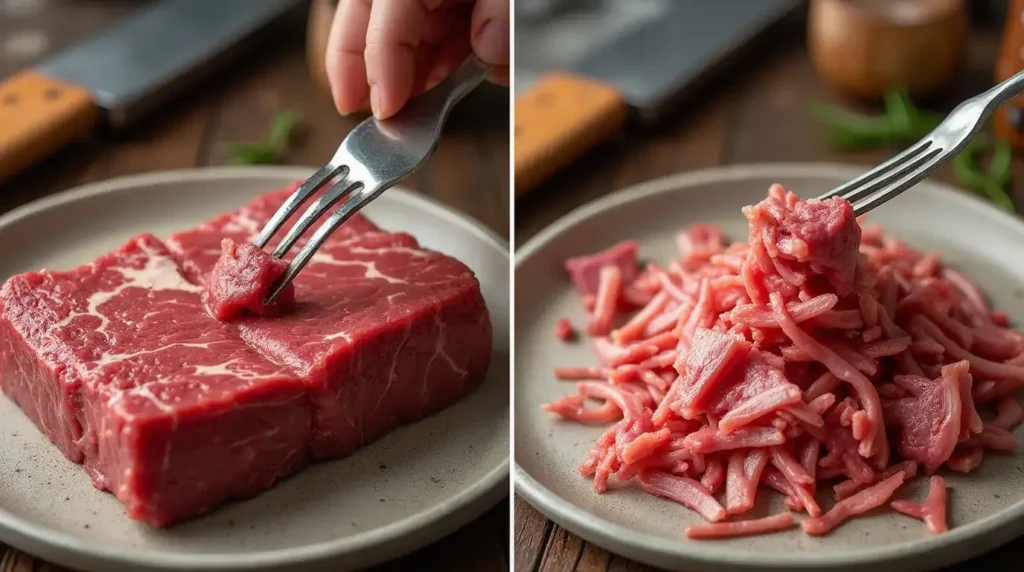When it comes to cooking beef, terms like pulled beef and shredded beef are often tossed around. But what’s the real difference? Are they just two ways of saying the same thing, or is there more to it? Well, you’re in for a treat! This article dives deep into the techniques, dishes, and cultural nuances behind these popular terms. We’ll explore why some recipes call for one over the other and how to decide which is best for your next culinary adventure. Let’s settle the question once and for all: Is it pulled beef or shredded beef?

Introduction to Pulled and Shredded Beef
Understanding the Terminology
Let’s start by clarifying what pulled beef and shredded beef mean. When you make pulled beef, you cook the meat slowly until it becomes tender enough to “pull” apart by hand or with forks. This process creates long, stringy, juicy strands that soak up sauces beautifully, making it ideal for hearty dishes like BBQ sandwiches.
Shredded beef, in contrast, involves mechanically cutting or tearing the meat into finer, more uniform pieces. Although it can still be tender, its texture differs—it’s less stringy and more consistent. You’ll often use shredded beef in dishes like enchiladas or stews, where a finer texture blends seamlessly with other ingredients.
Why the Distinction Matters
You might be thinking, “Why should I care?” But trust me, the distinction matters. The method impacts everything—from the meat’s texture to how it holds sauces and seasonings. Pulled beef shines in barbecue sandwiches, where its thick, hearty strands soak up smoky sauces. Meanwhile, shredded beef excels in layered dishes like tacos or casseroles, where a finer texture blends seamlessly with other ingredients.
As we dive deeper into the differences, we’ll explore recipes, techniques, and tips to help you choose the best method for your dish. So, whether you’re team pulled or team shredded, you’re about to become an expert!
Pulled Beef: Techniques and Uses
What Is Pulled Beef?
Pulled beef delivers on both patience and flavor. You prepare it by slow-cooking tougher cuts of beef, like chuck roast or brisket, until they become tender enough to pull apart easily with forks. This method often includes cooking the meat in a rich broth or sauce, which allows flavors to penetrate deeply. By the end, the beef turns juicy, flavorful, and perfectly ready to soak up additional seasonings or barbecue sauce.
If you’re wondering, “Is it pulled beef or shredded beef?”, the key difference lies in the texture. Pulling creates long, stringy fibers, making it ideal for hearty dishes like sandwiches or sliders. This method works best for recipes where bold sauces take center stage.
Best Recipes Featuring Pulled Beef
Pulled beef shines in dishes where texture and flavor are equally important. Take BBQ pulled beef sandwiches, for instance. The smoky, tangy sauce clings to the strands of beef, creating a melt-in-your-mouth experience. Pair that with a toasted bun and some creamy coleslaw, and you’ve got a classic comfort food.
For those who love Tex-Mex flavors, pulled beef tacos are a hit. Add some shredded lettuce, fresh salsa, and a squeeze of lime, and you’ve got a meal that’s both satisfying and versatile. You can also use pulled beef in baked dishes, like shepherd’s pie, where its stringy texture pairs beautifully with creamy mashed potatoes.
Why Some Prefer Pulled Over Shredded Beef
Texture is a big reason people lean toward pulled beef. The long, fibrous strands hold sauces better than finely shredded pieces, making it a favorite for barbecue lovers. Additionally, the slow-cooking process intensifies the beef’s natural flavors, delivering a depth that’s hard to beat. If you’re wondering, “Is it pulled beef or shredded beef I should use for bold-flavored dishes?”, pulled beef is often the answer.

Shredded Beef: Techniques and Uses
What Is Shredded Beef?
Shredded beef has its own distinct identity, even though it shares similarities with pulled beef. Instead of creating long strands, you break shredded beef into finer, uniform pieces. The process often begins with pulling apart slow-cooked meat using forks, but it may also involve chopping or using a hand mixer to create a more delicate texture.
When asking, “Is it pulled beef or shredded beef?”, shredded beef blends seamlessly into many recipes. Its smaller size makes it ideal for dishes like stews, burritos, or enchiladas, where even texture plays a key role in the overall flavor and presentation.
Dishes That Highlight Shredded Beef
One of the best uses for shredded beef is in stews and soups. The finer texture allows the meat to absorb broth and seasonings evenly, creating a comforting, flavorful dish. Think of shredded beef enchiladas—each bite offers a perfect mix of meat, sauce, and cheese.
Shredded beef also works wonders in sandwiches and wraps, especially when paired with bold flavors like chipotle or garlic. For an international twist, try it in Vietnamese banh mi. The shredded texture complements the crusty bread and crisp vegetables, offering a perfect balance of textures.
How Shredded Beef Differs from Pulled Beef
So, is it pulled beef or shredded beef that works best for certain dishes? The difference often comes down to texture and method. Pulled beef creates long, thick strands, while shredded beef results in finer, more delicate pieces. Shredded beef is perfect for recipes where the meat needs to mix evenly with other ingredients. If you’re making a stew, casserole, or sandwich that requires uniformity, shredded beef is the way to go.
The Cultural Perspective
Regional Preferences in Meat Preparation
When deciding “Is it pulled beef or shredded beef?”, it’s fascinating to explore how different regions approach meat preparation. In the Southern United States, the term pulled dominates conversations about barbecue. Pulled pork and pulled beef are staples in Southern BBQ, with the long, stringy texture complementing rich, smoky sauces.
In contrast, shredded beef takes center stage in many international cuisines. Mexican dishes, for instance, frequently use shredded beef for tacos, burritos, and enchiladas, where the finely shredded texture blends beautifully with spices and fillings. Meanwhile, shredded beef also shines in Vietnamese banh mi, showcasing its versatility in global cooking.
Etymology of Pulled vs. Shredded
Ever wondered why some meats are “pulled” while others are “shredded”? It often comes down to how the terms sound and their historical usage. Pulled meats typically describe the manual, rustic process of separating long strands of meat, often seen in traditional barbecue culture. Shredded, on the other hand, refers to a more mechanical or uniform breakdown of meat, often used in dishes requiring consistency.

Read morethis recipe for shredded beef crockpot preparation. It’s a great starting point for experimenting with slow-cooked beef.
How to Choose Between Pulled and Shredded Beef
Factors to Consider
If you’re pondering “Is it pulled beef or shredded beef I should use?”, the answer lies in the dish you’re making. Pulled beef works best in recipes where bold, thick sauces take center stage, like BBQ sandwiches or sliders. Its stringy texture holds the sauce beautifully and offers a hearty bite.
Shredded beef, however, is the better choice for dishes requiring finer meat pieces. Think of stews, soups, or tacos, where the smaller size of the beef helps it mix seamlessly with other ingredients. Additionally, your choice might depend on the available cuts—brisket and chuck roast excel for pulling, while beef cheeks or short ribs are perfect for shredding.
Adapting Recipes to Either Style
What if your recipe calls for one, but you prefer the other? Good news—you can adapt! To turn shredded beef into a pulled texture, slow cook it slightly longer and pull it apart with forks instead of shredding it finely. Conversely, if you need shredded beef from pulled meat, chop it further after cooking.
By understanding these techniques, you can confidently decide whether pulled beef or shredded beef suits your meal. Experimentation is key, so don’t hesitate to try both styles to find your favorite!
FAQs
What’s the difference between pulled and shredded?
The main difference between pulled and shredded lies in the texture and preparation method. In pulled meat, cooks slow-cook tougher cuts until they become tender enough to manually “pull” apart into long, stringy strands. For shredded meat, the process involves breaking the meat into finer, uniform pieces, often using forks or tools. Pulled meat offers a rustic, fibrous texture, while shredded meat works better in recipes requiring even distribution, such as tacos or enchiladas.
What does it mean when meat is pulled?
When you pull meat, you cook it until it becomes tender enough to separate into strands using forks or hands. This technique often involves slow-cooking to break down connective tissues, creating juicy and flavorful results. People often use pulled meat in barbecue dishes, where it absorbs sauces beautifully.
Does pulled beef exist?
Yes, pulled beef exists and makes a delicious alternative to pulled pork. Many cooks use cuts like chuck roast or brisket for pulled beef because their marbling and connective tissue break down well during slow cooking. Pulled beef works perfectly for BBQ sandwiches, sliders, and tacos, offering a rich, beefy flavor.
What is the meaning of shredded meat?
Shredded meat describes meat torn or cut into smaller, finer pieces. Unlike pulled meat, which separates into long strands, shredding produces a uniform, delicate texture. Many recipes, such as stews, enchiladas, and salads, require shredding because the finer pieces mix well with other ingredients. You can shred meat by hand, with forks, or using a mixer.

Conclusion
So, is it pulled beef or shredded beef that’s better? The answer lies in your recipe. Pulled beef, with its hearty strands, is perfect for barbecue sandwiches and bold flavors. Shredded beef, with its finer texture, works wonders in stews, tacos, and casseroles.
Ultimately, both styles have their strengths, and understanding their differences helps you make the best choice for your dish. Whether you prefer the rustic charm of pulled beef or the delicate consistency of shredded beef, experimenting with both will expand your culinary skills. Now, it’s time to get cooking and discover your favorite!

